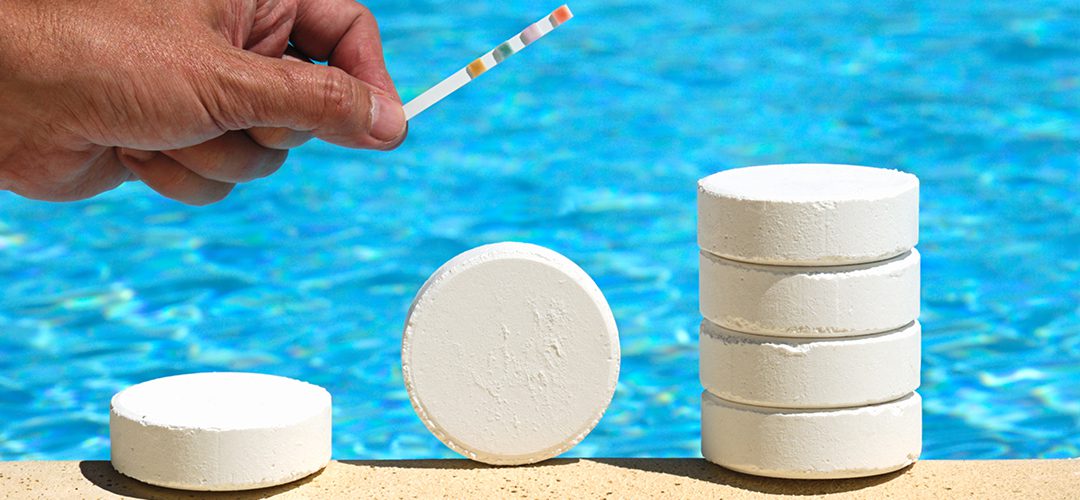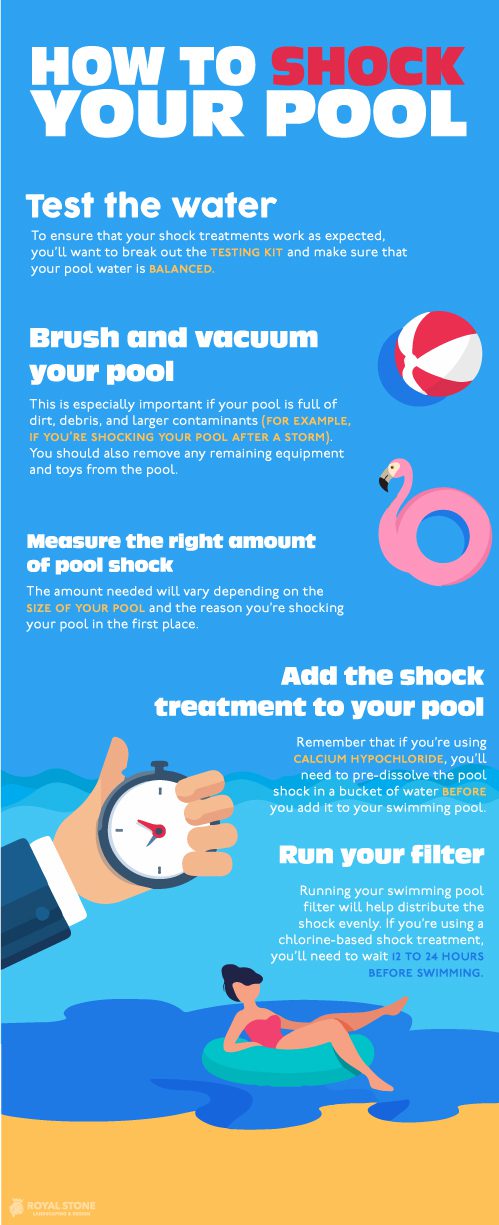
Pool shock is a chemical treatment that helps break down contaminants – such as leaves, dirt and debris, even oils from your skin — that can gradually build up in your pool water. Shocking your pool as part of your weekly pool maintenance routine will help keep your water clear and balanced.
New to pool shock? Have questions about how — or when — to shock your pool? Wondering which shock treatment is best for your pool? In this guide, we’ll answer some of the most common questions about pool shock.
What is pool shock? And what does it mean to “shock” your pool?
The term “pool shock” refers to a super-concentrated dose of pool sanitizer. Pool shock treatments are usually sold in granular form, and you can find them at just about any pool supply store or big-box home improvement store. Swimming pool shock treatments are available in chlorine and non-chlorine/oxygen-based formulations.
When you shock your swimming pool, you’re intentionally over-treating your water. The excess dose of chlorine (or oxygen, if you’re using a non-chlorine formulation) kills off bacteria and neutralizes contaminants that might otherwise cloud your pool water or encourage the growth of algae or harmful bacteria.
Which type of pool shock is right for you?
There are three basic types of shock treatments available for your pool: Calcium Hypochloride, Dichloroisocyanuric Acid and Potassium Peroxymonosufate. . Need help selecting the right shock treatment for your pool? Check our guide to the different types of pool shock.
When should you shock your pool? And how often?
These are probably the two most common questions that swimming pool owners have about pool shock. And, like many pool-related questions, there’s no single “right” answer.
The short, simple answer to both questions is, it depends on several factors, like how much you use your pool and if it has been exposed to any contaminants. The guidelines below should help you decide when to shock your pool:
As part of your pool maintenance regimen.
Swimming pools are a lot of fun – but they’re also a lot of work. As a swimming pool owner, you’re responsible for keeping your pool clean and free of debris. You’re responsible for ensuring that your pump and filtration system is working correctly. And perhaps most importantly, you’re responsible for testing your water, keeping your water chemistry balanced, and brushing and vacuuming your pool.
If you aren’t doing it already, consider shocking your pool every other week as part of your pool maintenance routine. If your pool gets moderate use, shocking it every other week will help ensure that your water is clear, clean, and free of any harmful bacteria or organic matter. For extra heavy pool use, consider shocking every week instead.
After a storm, spill, or other unexpected event.
Shock treatments can definitely help with the day-to-day maintenance of your swimming pool. But these super-powerful sanitizers really shine when it comes to cleaning up after the unexpected or totally-not-routine stuff. This could be anything from a thunderstorm (think: dirt, leaves, and debris) to a super-crowded pool party (think: sweat, oil and sunscreen; urine).
It’s a good idea to shock your pool after any event that can potentially leave your pool water contaminated. You’ll kill off all harmful particles, organic matter, and bacteria before they have a chance to affect your water quality.
After an outbreak of algae or green pool water.
Got algae? Has your pool water turned an unappealing shade of green [SH3] overnight? Shocking your pool after you scrub and vacuum the algae blooms away can ensure that it doesn’t come back.
A few things to keep in mind when you’re dealing with algae: First remember that pool shock is just one part of the algae removal process
How much pool shock do you need?
The amount of shock you need to use will depend mostly on the size of your pool (the larger and deeper the pool, the more shock you’ll need to get the job done) and the reason you’re shocking your pool (a black algae outbreak will require more doses than a post-pool party cleanup).
A good general guideline is to use one or two pounds of shock per 10,000 gallons of water (again, this is a very general guideline — be sure to read the instructions to find out exactly how much shock to use in your pool).
How to shock your pool
Shocking your pool isn’t terribly complicated. If you can test and balance your water chemistry, you can shock your pool. Although the shock process can vary a bit, you’ll follow a few basic steps:

Safety first!
Pool shock treatments can irritate your skin and eyes, so take these safety precautions when using them:
- Don’t allow kids or pets near the pool when the shock chemicals are in use.
- If you’re using a chlorine-based pool shock, be sure to wait 12 to 24 hours before allowing anyone into the pool again.
- Avoid shocking your pool when it’s windy out. A strong breeze can blow the chemicals back at you instead of into the pool.
- Be sure to read and follow all the instructions on your package of pool shock.
- Wear protective gear – including goggles and gloves — when working with pool shock.
- Wash your hands immediately after shocking your pool.
- Store and handle pool shock carefully. Remember that some types of pool shock are extremely flammable – and they can even explode if handled carelessly.
- Do not mix pool shock with other chemicals (or other types of pool shock). We can’t stress this enough. Mixing chemicals – especially pool shock – is super-dangerous.


Recent Comments